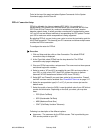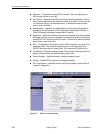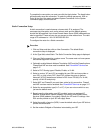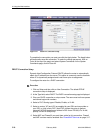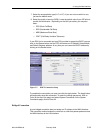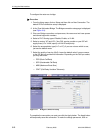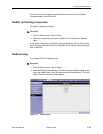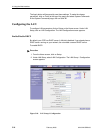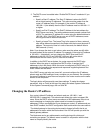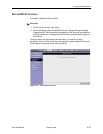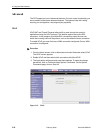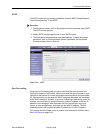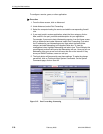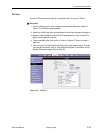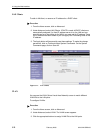
3. Using the Web Interface
6218-A2-GB20-00 February 2005
3-15
3. The DHCP server is enabled when “Enable DHCP Server” is selected. If you
enable it:
— Specify a Start IP address. The Start IP Address is where the DHCP
server starts issuing IP addresses. This value must be greater than the
router's IP address value. For example, if the router's IP address is
192.168.1.1 (the default) than the Start IP address must be 192.168.1. 2
or higher.
— Specify an End IP address. The End IP Address is the last address the
DHCP server can issue. The ending address cannot exceed a subnet limit
of 254. The maximum IP address for a router using the default address is
192.168.1.254. If the DHCP server runs out of DHCP addresses, users
will not get access to network resources.
— Specify a Lease Time. The Lease Time is the amount of time a network
user will be allowed connection to the Router with their current dynamic IP
address. The amount of time is in units of seconds; the default value is
3600 seconds (1 hour).
Note: If you change the start or end values, make sure the values are still within
the same subnet as the router's IP address. For example, if the router's IP address
is 192.168.1.1 (the default), and you change the DHCP Start and End IP
addresses to be 192.128.1.2 and 192.128.1.100, you will not be able to
communicate with the router if your PC has DHCP enabled.
In addition to the DHCP server feature, the router supports the DHCP relay
function. When the router is configured as DHCP server, it assigns the IP
addresses to the LAN clients. When the router is configured as DHCP relay, it is
responsible for forwarding the requests and responses negotiating between the
DHCP clients and the server.
If the DHCP server and relay are turned off, you must configure the IP address,
subnet mask and DNS settings of every computer on your network. Do not assign
the same IP address to more than one computer. Your router must be on the same
subnet as the computers.
The Apply button will temporarily save these settings. To make the change
permanent, click on Tools (at the top of the page) and select System Commands.
At the System Commands page, click on Save All.
Changing the Router's IP address
Your router's default IP address and subnet mask are 192.168.1.1 and
255.255.255.0, respectively. This subnet mask allows the router to support 254
users. Since the DHCP server issues a maximum of 255 addresses, there is not
much advantage to changing the subnet mask to increase the number of
addresses. Further, remember that if you change your router’s IP address and you
have DHCP enabled, the DHCP configuration must reside within the same subnet.
The default gateway is the routing device used to forward all traffic that is not
addressed to a station within the local subnet. Your ISP will provide you with the
default gateway address.
The Hostname can be any alphanumeric word beginning with a letter and
containing no spaces. The domain name is used to in conjunction with the host
name to uniquely identify the router.



